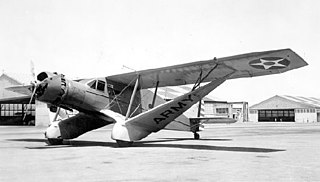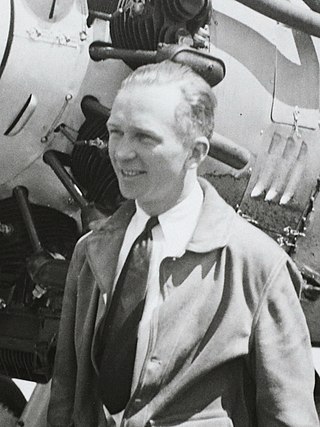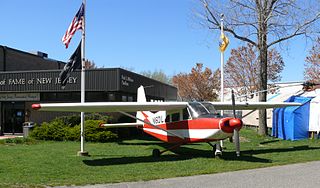
AviaBellanca Aircraft Corporation was an American aircraft design and manufacturing company. Prior to 1983, it was known as the Bellanca Aircraft Company. The company was founded in 1927 by Giuseppe Mario Bellanca, although it was preceded by previous businesses and partnerships in which aircraft with the Bellanca name were produced, including Wright-Bellanca, in which he was in partnership with Wright Aeronautical.

The Orteig Prize was a reward offered to the first Allied aviator(s) to fly non-stop from New York City to Paris or vice versa. Several famous aviators made unsuccessful attempts at the New York–Paris flight before the relatively unknown American Charles Lindbergh won the prize in 1927 in his aircraft Spirit of St. Louis. However, a number of people died who were competing to win the prize. Six men died in three separate crashes, and another three were injured in a fourth crash. The Prize occasioned considerable investment in aviation, sometimes many times the value of the prize itself, and advancing public interest and the level of aviation technology.

The Spirit of St. Louis is the custom-built, single-engine, single-seat, high-wing monoplane that was flown by Charles Lindbergh on May 20–21, 1927, on the first solo nonstop transatlantic flight from Long Island, New York, to Paris, France, for which Lindbergh won the $25,000 Orteig Prize.

Bertrand Blanchard Acosta was a record-setting aviator and test pilot. He and Clarence D. Chamberlin set an endurance record of 51 hours, 11 minutes, and 25 seconds in the air. He later flew in the Spanish Civil War in the Yankee Squadron. He was known as the "bad boy of the air". He received numerous fines and suspensions for flying stunts such as flying under bridges or flying too close to buildings.

The Bellanca Aircruiser and Airbus were high-wing, single-engine aircraft built by Bellanca Aircraft Corporation of New Castle, Delaware. The aircraft was built as a "workhorse" intended for use as a passenger or cargo aircraft. It was available with wheels, floats or skis. The aircraft was powered by either a Wright Cyclone or Pratt and Whitney Hornet engine. The Airbus and Aircruiser served as both commercial and military transports.

The Spirit of St. Louis is a 1957 aviation biography film in CinemaScope and Warnercolor from Warner Bros., directed by Billy Wilder, produced by Leland Hayward, and starring James Stewart as Charles Lindbergh. The screenplay was adapted by Charles Lederer, Wendell Mayes, and Billy Wilder from Lindbergh's 1953 autobiographical account of his historic flight, which won the Pulitzer Prize in 1954.

The America was a Fokker C-2 trimotor monoplane that was flown in 1927 by Richard E. Byrd, Bernt Balchen, George Otto Noville, and Bert Acosta on their transatlantic flight.

Clarence Duncan Chamberlin was an American pioneer of aviation, being the second man to pilot a fixed-wing aircraft across the Atlantic Ocean, from New York to the European mainland, while carrying the first transatlantic passenger.

Giuseppe Mario Bellanca was an Italian-American aviation pioneer, airplane designer and builder, who is credited with many design firsts and whose aircraft broke many aviation records. He was inducted into the National Aviation Hall of Fame in 1973. The Bellanca C.F., one of the world's first enclosed-cabin monoplanes, is on display at the National Air and Space Museum. Bellanca was known mostly for his long range aircraft which led the way for the advancement of international and commercial air transportation.

Charles Albert Levine was the first passenger aboard a transatlantic flight. He was ready to cross the Atlantic to claim the Orteig prize but a court battle over who was going to be in the airplane allowed Charles Lindbergh to leave first.

The Aviation Hall of Fame & Museum of New Jersey was founded in 1972 and preserves New Jersey's aviation and space heritage. The museum displays historic aircraft, space equipment, artifacts, photographs, art and an aircraft model collection. The library has more than 4,000 volumes and a collection of aviation video. It is located at Teterboro Airport, the oldest operating airport in the Tri-State Region, at 400 Fred Wehran Drive, Teterboro, New Jersey.

The Bellanca CH-300 Pacemaker was a six-seat utility aircraft, built primarily in the United States in the 1920s and 1930s. It was a development of the Bellanca CH-200, fitted with a more powerful engine and, like the CH-200, soon became renowned for its long-distance endurance.

The Wright R-790 Whirlwind was a series of nine-cylinder air-cooled radial aircraft engines built by Wright Aeronautical Corporation, with a total displacement of about 790 cubic inches (12.9 L) and around 200 horsepower (150 kW). These engines were the earliest members of the Wright Whirlwind engine family.
The Columbia Aircraft Corporation was an American aircraft manufacturer, which was active between 1927 and 1947.

The Bellanca CE was the first aircraft designed for the Maryland Pressed Steel Company, by the aircraft designer Giuseppe Mario Bellanca. The aircraft was also called the Bellanca C.E. or the "CE Tractor Biplane".

The Wright-Bellanca WB-2, was a high wing monoplane aircraft designed by Giuseppe Mario Bellanca, initially for Wright Aeronautical then later Columbia Aircraft Corp.

The Wright-Bellanca WB-1 was designed by Giuseppe Mario Bellanca for the Wright Aeronautical corporation for use in record-breaking flights.

Lloyd Wilson Bertaud was an American aviator. Bertaud was selected to be the copilot in the WB-2 Columbia attempting the transatlantic crossing for the Orteig Prize in 1927. Aircraft owner Charles A. Levine wanted to fly in his place, and an injunction by Bertaud against Levine prevented the flight. Aviator Charles Lindbergh won the prize.
Columbia Field, originally Curtiss Field, is a former airfield near Valley Stream within the Town of Hempstead on Long Island, New York. Between 1929 and 1933 it was a public airfield named Curtiss Field after the Curtiss-Wright aircraft corporation that owned it. The public airfield closed after 1933, but aircraft continued to be manufactured there primarily by Columbia Aircraft Corporation, which gave the private airfield its name.

The Bellanca Airfield Museum is an aviation museum located in New Castle, Delaware focused on the history of Bellanca Airfield.























